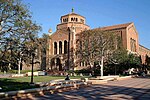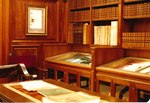The UCLA College of Letters and Science (or simply UCLA College) is the arts and sciences college of the University of California, Los Angeles (UCLA). It encompasses the Life and Physical Sciences, Humanities, Social Sciences, Honors Program and other programs for both undergraduate and graduate students. It is often called UCLA College or the College, which is not ambiguous because the College is the only educational unit at UCLA to be currently denominated as a "college." All other educational units at UCLA are currently labeled as schools or institutes.
The College is the largest academic unit at UCLA and the largest in the entire UC system. The bulk of UCLA's student body belongs to the College, which includes 50 academic departments, 99 majors, 25,000 undergraduate students, 2,700 graduate students and 900 faculty members. Virtually all of the academic programs in the College are ranked very highly and 11 were ranked in the top ten nationally by the National Research Council.
The College originated on May 23, 1919, the day when the Governor of California (William D. Stephens) signed a bill into law which officially established the Southern Branch of the University of California. At that time, a two-year Junior College was established as the university's general undergraduate program. The Junior College held its first classes on September 15, 1919 for 260 undergraduates.At its inception, the Junior College was truly a junior college in both name and fact, because it offered only a two-year lower-division program. Young people interested in earning bachelor's degrees were required to proceed to the Berkeley campus or other universities to attend upper-division third- and fourth-year courses. The inferior two-year program was intolerable to the many Southern Californians who had fought to establish the southern branch. They vigorously lobbied the Regents of the University of California for a third year of instruction at the southern branch, which was promptly followed by demands for a fourth year. The Southern Californians finally prevailed on December 11, 1923, when the UC Board of Regents approved a fourth year of instruction.At that time, the Junior College was transformed into the College of Letters and Science (named after its northern counterpart at Berkeley) and was expressly authorized to award the Bachelor of Arts degree. Charles H. Rieber, a philosophy professor, was named the first dean of the new four-year college. The College's original departments in 1923 were chemistry, economics, English, French, history, mathematics, philosophy, physics, political science, psychology, Spanish, and zoology.On June 12, 1925, the College awarded its first Bachelor of Arts degrees to 98 women and 30 men.According to UC President Clark Kerr, the political science department at UCLA College in his experience was the second-strongest program in the entire UC system after the chemistry program at Berkeley. To date, three faculty members of the UCLA political science department have become UC chancellors (as listed below).
The main disadvantage of the gigantic size of the College (as with its counterpart at Berkeley) is a coldly impersonal undergraduate experience, especially in large lower-division survey courses (before students declare specific majors, begin to work more closely with department advisers and faculty members in their chosen major, and switch to smaller upper-division courses). It is because of this specific issue that UC President Clark Kerr experimented with residential college systems at the newer UC campuses at San Diego and Santa Cruz.








